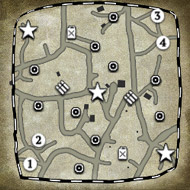
General Feedback
Wehrmacht Feedback
USA Feedback
Combat Feedback
Maps
UI and UX

Posts: 713 | Subs: 2

Posts: 1116 | Subs: 1
Posts: 1614 | Subs: 3
From what I got playing USF and Wehr - USF was much-MUCH more finished then the Wehr imo.
Like for instance this whole idea behind Luft\PG tiers is cool, but luft was wastly infirrior to PGs in pretty much every single scenario, it was playable but totaly infirrior.
It is also pretty clear that Wehr is kinda not supposed to have both T2\T3 at the same time, without being punished for that res vise. This only leads to the fact either both tiers should be equally strong or we will be left with soviet T1\T2 situation.
Upgrading T1\T2 is also badly thought out, because you was able to get stug\wilberwind at 8 minute mark if you rush it. Pretty much at the time USF got access to LVs.
So idk, for me Alpha just shown some working and not so much concepts, but I think it was rolled out way to early. Because, as I was saying, it felt like wehr was just quickly made up into its MP version from SP, while USF was more or less in a finished state.
Also it wasnt helping, that we didnt exactly know what is finished and what is not (aside of oblivious things). Relic really should have given at least some sort of a guideline on what we should have been looking at and about what feedback is needed.
Posts: 570 | Subs: 1
Posts: 2159 | Subs: 2
Posts: 66

Posts: 875 | Subs: 6

Posts: 1820 | Subs: 2
I did not see any re cover in matches I saw. Is there red cover in Coh3?
Posts: 3046 | Subs: 3
 Definitely gonna try to pass this on
Definitely gonna try to pass this onPosts: 545 | Subs: 3
Posts: 713 | Subs: 2

Posts: 1594

Posts: 1820 | Subs: 2
Posts: 713 | Subs: 2
"Audible Footsteps
Footsteps in the fog of war give away infantry positions. Predicting infantry movement is a major part of CoH and hearing the footsteps prevents this layer of depth."
You have this in both previous games, also units speech in fog of war is a thing.

Posts: 578
Automating reinforcing doesn’t really hurt the core gameplay that much
One thing that should definitely be considered is constricting auto-reinforce to HQ sectors. Some strategies are balanced around being limited by available micro, namely halftrack and bunker play, and auto reinforce severely lowers this “micro tax”, making these deathball type strategies way too easy to execute for how hard they are to counter. Also, by auto reinforce being available on the frontline, it takes value away from merge, because you won’t disable auto reinforce just to save some manpower with merge.
The Medic upgrade has the same issues as the 251 for Wehrmacht in that most micro requirements have been removed as a result of autohealing, auto reinforce and easy team weapon recapture, resulting in halftrack play becoming very hard to counter for how easy it is to pull off.

Posts: 875 | Subs: 6
I'd rather see auto-reinforce available wherever one can reinforce, and then merge becomes the combat version of reinforce. Maybe it should take twice as long to reinforce outside HQ.

Posts: 1820 | Subs: 2
Is it really? Is it possible in CoH1 and/or CoH2 to determine infantry positions in the FoW? At least it's easier in CoH3.
Posts: 1614 | Subs: 3
Auto-reinforce in base only sounds like l33t tax that doesn't help the game in any way except making more micro, because you're adding clicks based on where the unit is reinforcing. That's not consistent design.
I'd rather see auto-reinforce available wherever one can reinforce, and then merge becomes the combat version of reinforce. Maybe it should take twice as long to reinforce outside HQ.
"Audible Footsteps
Footsteps in the fog of war give away infantry positions. Predicting infantry movement is a major part of CoH and hearing the footsteps prevents this layer of depth."
You have this in both previous games, also units speech in fog of war is a thing.
Recently played CoH and I heard infantry movement in the fog.

Posts: 1820 | Subs: 2
Posts: 713 | Subs: 2
Alright, funny how I assumed it was a thing for CoH2 as well, I swear. Sorry for the misinformation I haven't played CoH2 for some time.
 |
|
|
11 | ||
 |
|
|
1 |
 cblanco ★
cblanco ★  보드카 중대
보드카 중대  VonManteuffel
VonManteuffel  Heartless Jäger
Heartless Jäger 